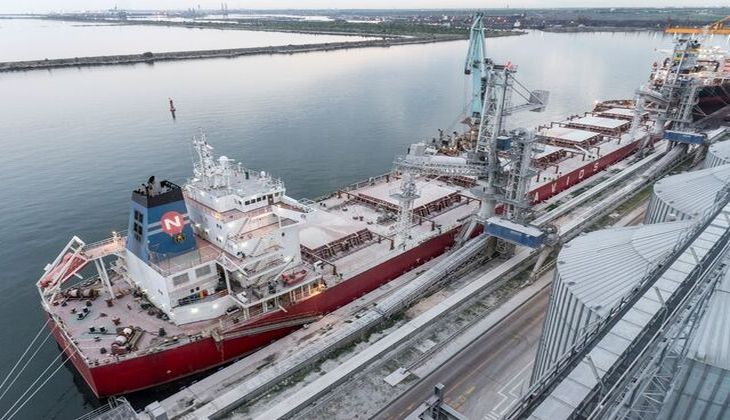Romania’s top port unfit to solve EU’s challenge to bring grain out of Ukraine

With Ukrainian ports blocked by Russian military forces since late February, Romania’s flagship Black Sea port, Constanta, has found itself on the front line to export Ukraine’s millions of tonnes of grain.
Constanta has become the substitute port for Odesa, a strategic partner to ship grain from the world’s fourth largest exporter. Ukraine must transport about 20m tonnes of grain in less than three months before the new crop of some 30m tonnes gets ready for harvest.
Constanta has seen shipping traffic for both containers and dry bulk leap in the opening months of the Ukrainian invasion. However, experts have questioned whether the millions of dollars it will take to improve infrastructure at its quayside and hinterland are worth it in the long run.
“The port can not transform itself in such a short time. It will only become more congested, and with limited space to store more cargo,” Ghiorghe Batrinca, associate professor at Constanta Maritime University, told Splash.
Last year, Constanta port shipped 25m tonnes of grain, becoming the first European port for grain exports, according to Romanian minister of foreign affairs Bogdan Aurescu. The port handles some 67m tonnes of goods each year, but the infrastructure surrounding Constanta remains a concern, preventing a considerable increase in supply from Ukraine.
Per Batrinca, the port can handle twice the cargo volume it does now, but when it comes to connecting with the hinterland, the road will not be a viable option because summer vacations are approaching, and with more traffic on the roads, it will soon reach its maximum capacity. For him, trains could be the best alternative, but due to the difference in rail gauges between Romania and Ukraine, there will not be many solutions in a short time.
The container terminals of Constanta have been overloaded since the end of March this year, with utilisation up to 90%, according to an analysis by the Odesa-based Black Sea consulting firm Informall BG. The total volume of containers in transit in Constanta tripled in the first quarter of 2022 compared to Q1 of 2021, with 7,000 teu being transported to Ukraine in March alone.
“There were many challenges in moving the cargo to Ukraine and most of it is still in the ports.The port had issues with hinterland connection due to lack of a highway network and the very poor performance of the rail sector, with an average speed in many cases below 150 km per day,” confirmed Batrinca.
Ukrainian crop logistics were also taking place at its river ports of Izmail, Reni and Kilia on the Danube River, which provide barge links with the port of Constanta, but according to Informall, they have fairly limited capacity as they were not designed to handle considerable volumes of bulk cargoes.
To put it in perspective, one of the bulk carriers that left Constanta with 70,000 tonnes of grain in April was filled by a combination of 49 barges and trains. One 600 m long train can carry around 1,900 tonnes of grain, while a convoy of six barges can handle a maximum of 18,000 tonnes.
“Barges are today the most suitable solution, but again there is a lack of capacity and there will be congestion since the loading rate in a ship from barges is well below what can be achieved,” remarked Batrinca.
The vessel congestion at the Sulina channel has been gradually increasing since March of this year. As of May 25, around 90 vessels were anchored ashore in the channel, and the approximate waiting time to enter the river waters is two weeks, according to Informall data.
“Constanta Port could be a lifeline for the Ukrainian agri-industry, however, starting from Q2 2022, the logistics of Ukrainian agricultural products through Romania will become more complicated due to the seasonal shipments of Romanian harvest, winter wheat, and barley, which are traditionally transhipped through the port infrastructure of Constanta,” Informall warned.
The cargo analytical bureau also suggested that bulk shipments of Ukrainian grains via the port of Constanta are not expected to show any major progress, mainly due to the Ukrainian domestic logistical challenges.
For Batrinca, the only solution to take out at least 10m tonnes of grain from Ukraine before the new crop comes is to put pressure on Russia to open at least the ports of Odesa and Chernomork.
EU diplomats in Ukraine have been reported saying that without the Black Sea route, only about 5m tonnes of grain can be shipped in time for the next crop.
Russian president Vladimir Putin told Turkish counterpart Recep Tayyip Erdogan on Monday that Moscow was ready to work with Ankara to free up maritime shipping blocked over the conflict in Ukraine. Black Sea navigation has also been hampered by mines placed by both Russian and Ukrainian forces.
Read also
Wheat in Southern Brazil Impacted by Dry Weather and Frosts
Oilseed Industry. Leaders and Strategies in the Times of a Great Change
Black Sea & Danube Region: Oilseed and Vegoil Markets Within Ongoing Transfor...
Serbia. The drought will cause extremely high losses for farmers this year
2023/24 Safrinha Corn in Brazil 91% Harvested
Write to us
Our manager will contact you soon



